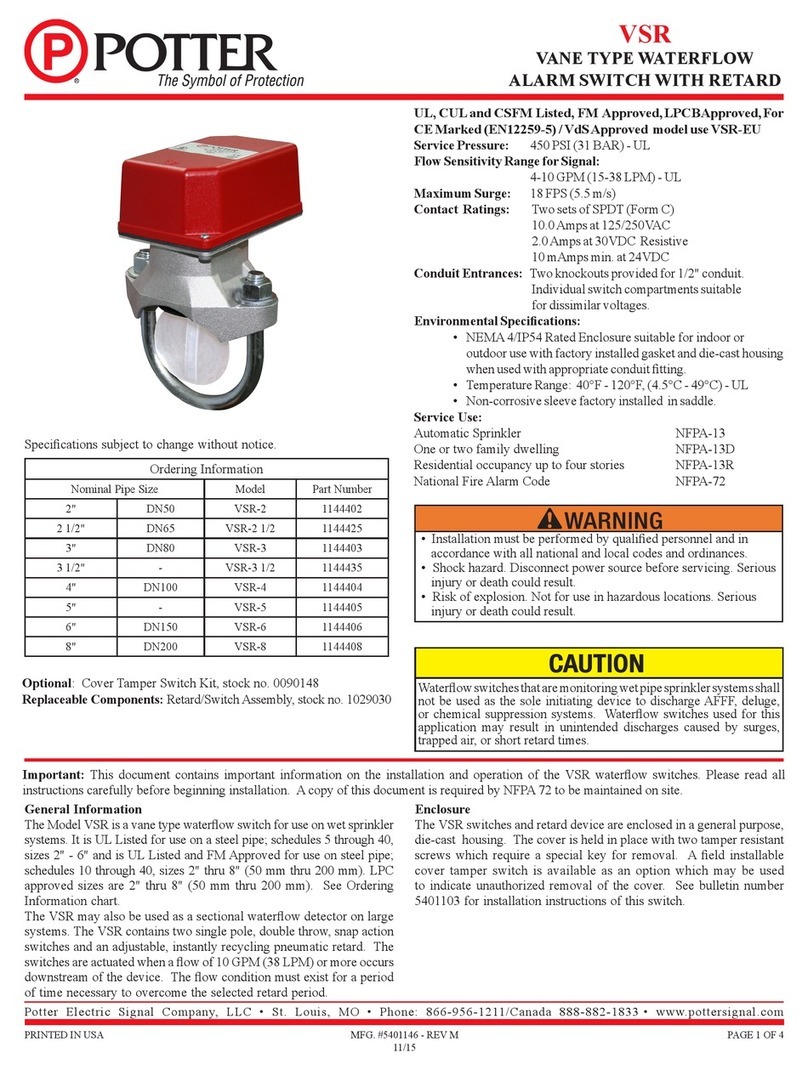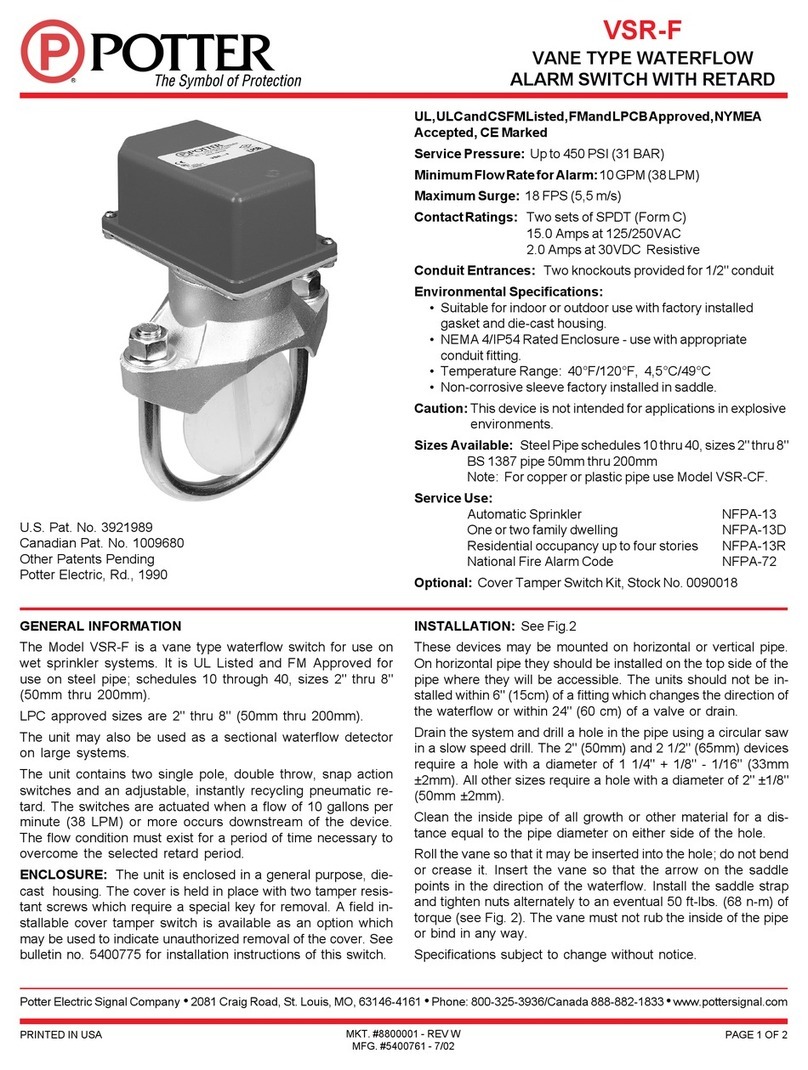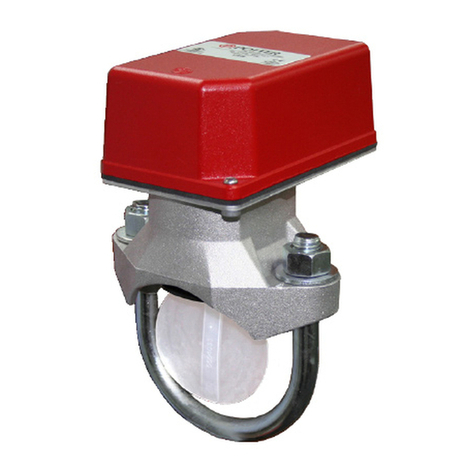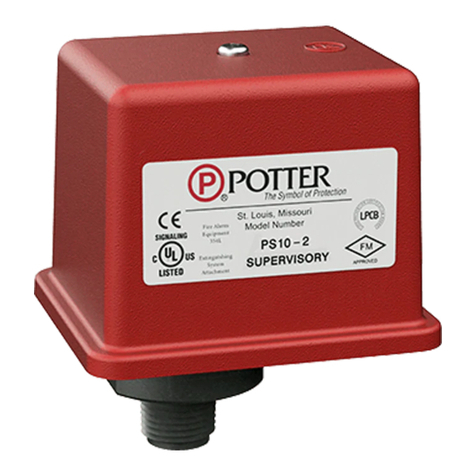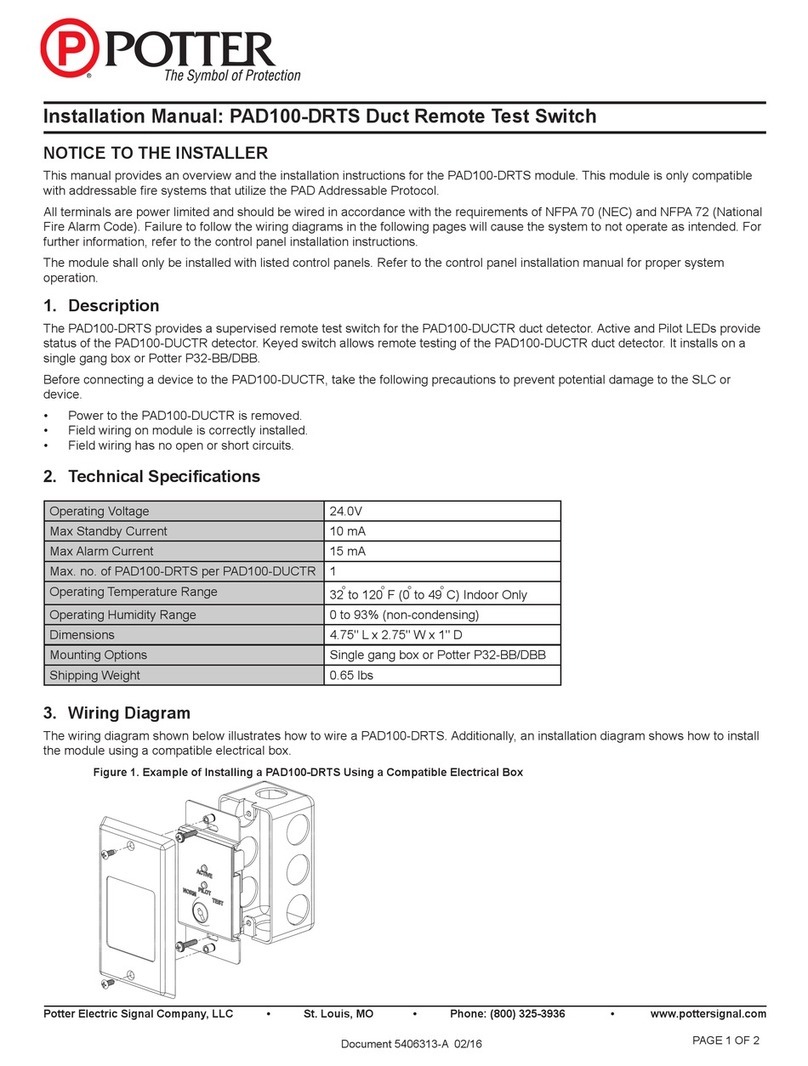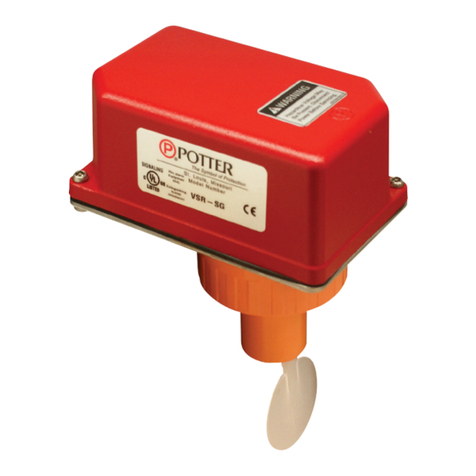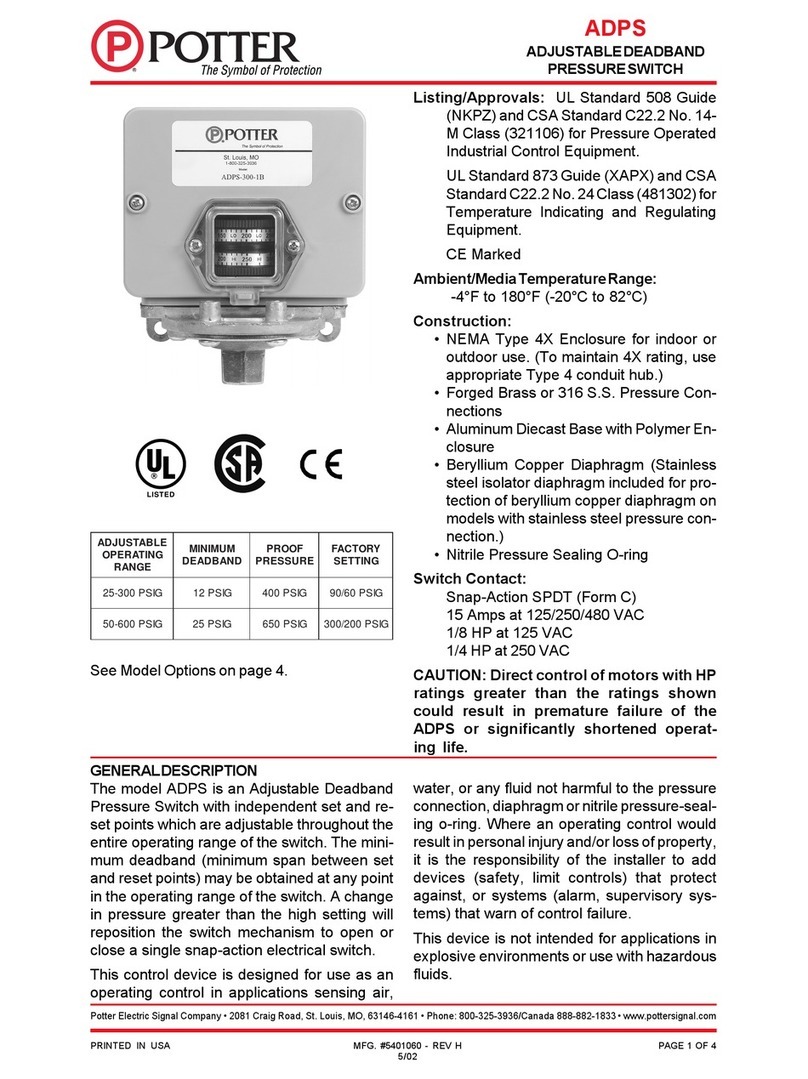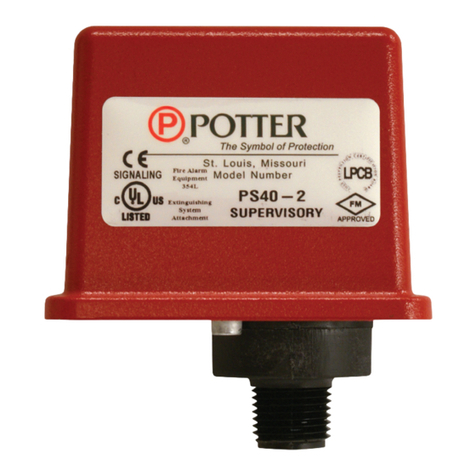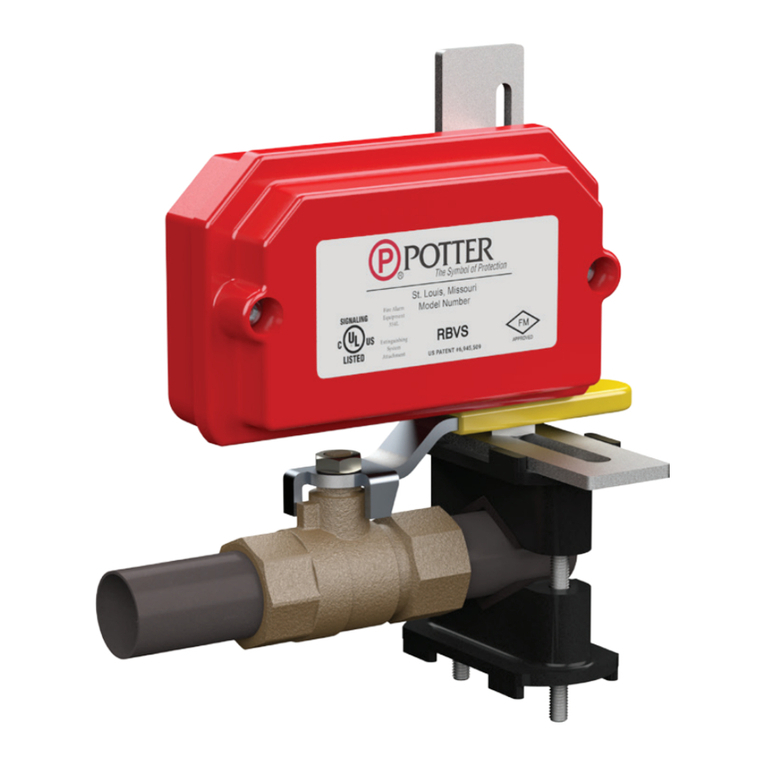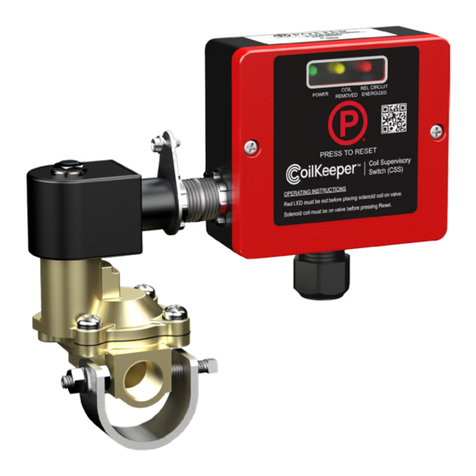
MFG. #5400933 - REV E
09/12
PRINTED IN USA PAGE 1 OF 3
PS120 SERIES
SUPERVISORY PRESSURE SWITCH
Installation
The Potter PS120 Series Supervisory Pressure Actuated Switches are
designed primarily to detect an increase and/or decrease from normal system
pressure in automatic re sprinkler systems. Typical applications are: Wet
pipe systems with excess pressure, pressure tanks, air supplies, and water
supplies. The PS120 switch is factory set for 120 PSI (8,3 BAR) normal
system pressure. The switch marked with the word LOW is set to operate at
a pressure decrease of 10 PSI (0,7 BAR) at 110 PSI (7,6 BAR). The switch
marked with the word HIGH is set to operate at a pressure increase of 10
PSI (0,7 BAR) at 130 PSI (9 BAR). See section heading Adjustments and
Testing if other than factory set point is required.
1. Connect the PS120 to the system side of any shutoff or check valve.
2. Apply Teon tape to the threaded male connection on the device.
(Do not use pipe dope)
3. Device should be mounted in the upright position.
(Threaded connection down)
4. Tighten the device using a wrench on the ats on the device.
Wiring Instructions
1. Remove the tamper resistant screw with the special key provided.
2. Carefully place a screwdriver on the edge of the knockout and sharply
apply a force sufcient to dislodge the knockout plug. See Fig. 9
3. Run wires through an approved conduit connector and afx the
connector to the device. A NEMA-4 rated conduit tting is required
for outdoor use.
Potter Electric Signal Company • St. Louis, MO • Customer Service: 866-572-3005 • Tech Support: 866-956-0988 • Canada 888-882-1833
•www.pottersignal.com
Service Use:
Automatic Sprinkler NFPA-13
One or two family dwelling NFPA-13D
Residential Occupancy up to four stories NFPA-13R
National Fire Alarm Code NFPA-72
UL, cUL, and CSFM Listed, FM and LPC Approved, NYMEA
Accepted, CE Marked
Dimensions: 3.78" (9.6cm)W x 3.20" (8.1cm)D x 4.22" (10.7cm)H
Enclosure: Cover- Die-cast with textured red powdercoat nish, single
cover screw and rain lip.
Base- Die-cast
Pressure Connection: Nylon 1/2" NPT male
Cover incorporates tamper resistant fastener that requires a
special key for removal. One key is supplied with each device.
For optional cover tamper switch kit, order Stock No. 0090200.
See bulletin #5401200 PSCTSK.
Switch Contacts: SPDT (Form C)
10.1 Amps at 125/250VAC, 2.0 Amps at 30VDC
One SPDT in PS120-1, Two SPDT in PS120-2
Environmental Specications:
NEMA 4/IP66 Rated Enclosure - indoor or outdoor when used
with NEMA 4 conduit ttings.
Temperature range: -40°F to 140°F (-40°C to 60°C)
Pressure Range: 25-175 PSI (1,7 - 12,1 BAR)
Differential: Typical 2 lbs. at 25 PSI (0,14 at 1,7 BAR)
8 lbs at 175 PSI (55 at 12,1 BAR)
Maximum System Pressure: 300 PSI (20,68 BAR)
Factory Adjustment: PS120-1 operates on decrease at 110 PSI (7,6 BAR)
PS120-2 operates in increase at 130 PSI (9 BAR) and
on decrease at 110 PSI (7,6 BAR)
Conduit Entrance: Two knockouts provided for 1/2" conduit. Individual
switch compartments and ground screw suitable for
dissimilar voltages
Tamper:
4. Connect the wires to the appropriate terminal connections for the
service intended. See Figures 2,4,5,6, and 8. See Fig. 7 for two switch
one conduit wiring.
Adjustment And Testing
The operation of the pressure supervisory switch should be tested upon
completion of installation and periodically thereafter in accordance with
the applicable NFPA codes and standards and/or the authority having
jurisdiction (manufacturer recommends quarterly or more frequently).
Note: Testing the PS120 may activate other system connected devices.
The use of a Potter BVL (see product bulletin 8900067 for details) is
recommended to facilitate setting and testing of the PS120 pressure switch.
When a BVL (bleeder valve) is used, the pressure to the switch can be
isolated and bled from the exhaust port on the BVL without effecting the
supervisory pressure of the entire system. See Fig. 3
The operation point of the PS120 Pressure Switch can be adjusted to any
point between 25 and 175 PSI (1,7 - 12,1 BAR) by turning the adjustment
knob(s) clockwise to raise the actuation point and counter clockwise to
lower the actuation point. In the case of the PS120-2, both switches operate
independent of each other. Each switch may be independently adjusted to
actuate at any point acrosss the switch adjustment range. Initial adjustment
can be made with a visual reference from the top of the adjustment knob
across to the printed scale on the switch bracket. Final adjustments should
be veried with a pressure gauge.
Ordering Information
Model Description Stock No.
PS120-1 Pressure switch with one set 1341203
SPDT contacts
PS120-2 Pressure switch with two sets 1341204
SPDT contacts
Hex Key 5250062
Cover Tamper Switch Kit 0090200
BVL Bleeder valve 1000018
